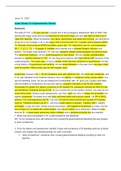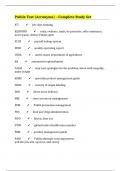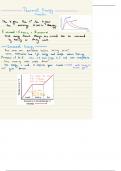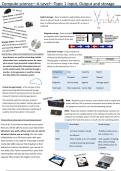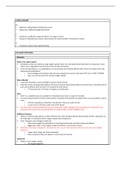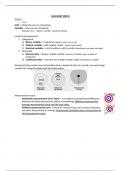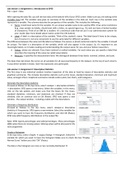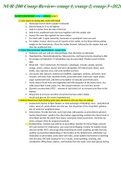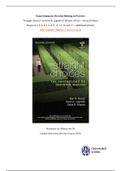Case Study 10: Hypovolemic Shock
Scenario
The wife of C.W., a 70-year-old man, brought him to the emergency department (ED) at 0430. She
told the ED triage nurse that he had diarrhea for the past 2 days and that last night he had a lot of
“dark red” diarrhea. When he became very dizzy, disoriented, and weak this morning, she decided to
bring him to the hospital. C.W.’s vital signs (VS) in the ED were 70/− (systolic blood pressure [SBP]
70, diastolic blood pressure [DBP] inaudible), pulse rate 110, respiratory rate 22, oral temperature
99.1 ° F (37.3 ° C). A 16-gauge IV catheter was inserted and a lactated Ringer’s infusion was
started. The triage nurse learned C.W. has had idiopathic dilated cardiomyopathy for several years.
The onset was insidious, but the cardiomyopathy is now severe. His last cardiac catheterization
showed an ejection fraction of 13%. He has frequent problems with heart failure (HF) because of the
cardiomyopathy. Two years ago, he had a cardiac arrest that was attributed to hypokalemia. He has
a long history of hypertension and arthritis. He had atrial fibrillation in the past, but it has been under
control recently. Fifteen years ago he had a peptic ulcer.
Endoscopy showed a 25- × 15-mm duodenal ulcer with adherent clot. The ulcer was cauterized, and
C.W. was admitted to the medical intensive care unit (MICU) for treatment of his volume deficit. You
are his admitting nurse. As you are making him comfortable, Mrs. W. gives you a paper sack filled
with the bottles of medications he has been taking: enalapril (Vasotec) 5 mg PO bid, warfarin
(Coumadin) 5 mg/day PO, digoxin (Lanoxin) 0.125 mg/day PO, potassium chloride 20 mEq PO bid,
and diclofenac (Voltaren) 50 mg PO tid. As you connect him to the cardiac monitor, you note he is in
sinus tachycardia. Doing a quick assessment, you find a pale man who is sleepy but arousable and
slightly disoriented. He states he is still dizzy and feels weak and anxious overall. His BP is 98/52,
pulse is 118, and respiratory rate 26. You hear S3 and S4 heart sounds and a grade II/VI systolic
murmur. Peripheral pulses are all 2+, and trace pedal edema is present. Capillary refill is slightly
prolonged. Lungs are clear. Bowel sounds are present, mid-epigastric tenderness is noted, and the
liver margin is 4 cm below the costal margin. Has not yet voided since admission. Rates his pain
level as “2.” A Swan-Ganz pulmonary artery catheter and a peripheral arterial line are inserted.
1. What may have precipitated C.W.’s gastrointestinal (GI) bleeding?
25× 15-mm duodenal ulcer with adherent clot caused the gastrointestinal bleeding that was present
in dark red diarrhea.
2. From his history and assessment, identify 5 signs and symptoms of GI bleeding and loss of blood
volume, and explain the pathophysiology for each one listed.
1. “dark red diarrhea”- duodenal ulcer caused gastrointestinal bleeding resulting in dark red
diarrhea
, 2. Dizzy, weak, and anxious- due to sudden drop of blood pressure due to bleeding
3. Low blood pressure- fluid volume deficit due to bleed
4. Disoriented- altered mental status is common with fluid volume deficit
5. Sleepy yet arousable – the patient is at risk of passing out due to loss of blood
3. What is the most serious potential complication of C.W.’s bleeding?
Hypovolemic Shock can lead to multi system organ failure and excessive cell damage when left
untreated.
4. Your institution uses electronic charting. Based on the most recent assessment, mentioned
previously, which of these systems would you mark as “abnormal” as you document your findings?
For abnormal findings provide a brief narrative note.
☐ Neurologic:
• very dizzy, disoriented, and weak this morning
• sleepy but arousable
• feels anxious
☐ Respiratory:
• respiratory rate 22 upon admission in ED
• respiratory rate 26 in MICU
☐ Cardiovascular:
• Blood pressure 70/− in ED. BP is 98/52 in MICU
• pulse rate 110
• history of idiopathic dilated cardiomyopathy
• admitted with severe insidious onset cardiomyopathy
• last cardiac catheterization showed an ejection fraction of 13%
• Two years ago, patient had cardiac arrest attributed to hypokalemia
• history of hypertension
• history of atrial fibrillation, currently under control
• cardiac monitor sinus tachycardia
• pulse is 118
• S3 and S4 heart sounds and a grade II/VI systolic murmur
• Peripheral pulses are all 2+ and trace pedal edema is present
• Capillary refill is slightly prolonged
• A Swan-Ganz pulmonary artery catheter and a peripheral arterial line are inserted
☐ GI:
• diarrhea for the past 2 days
• last night patient had a lot of “dark red” diarrhea

